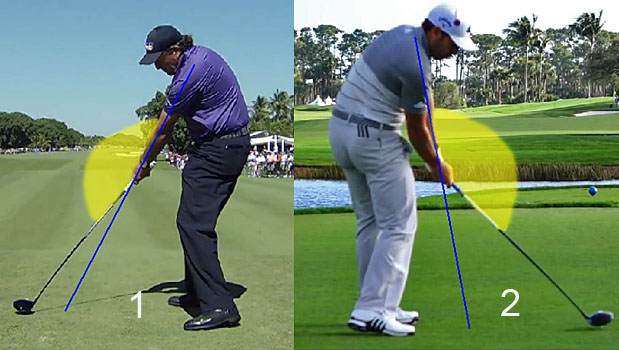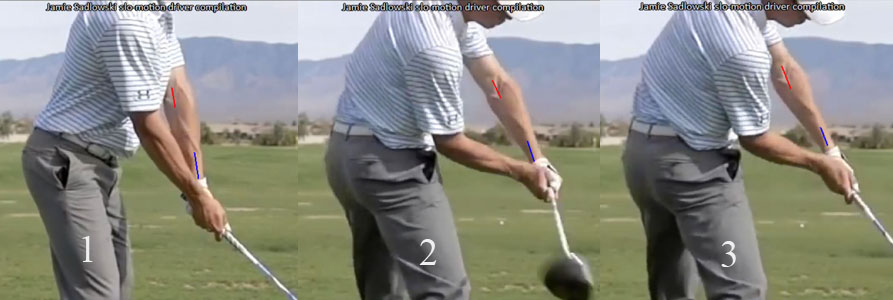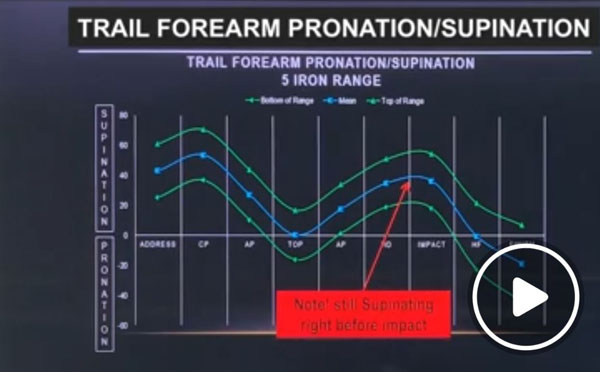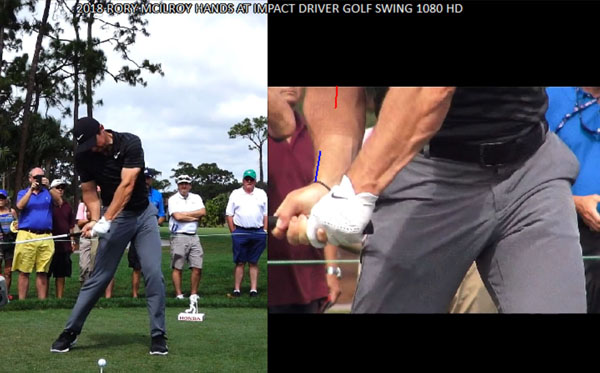|
|
Post by imperfectgolfer on Jan 16, 2023 23:59:06 GMT -5
cseric (new member) tried to start a thread regarding the following AMG video, but it had no content, so I deleted that thread and started this thread on his behalf. What do I think of the video? It is amazing from a graphics perspective. The AMG videos have no peer when it comes to producing amazing graphic content. Regarding their opinions regarding the biomechanics of the clubshaft shallowing action, I agree that it does not involve external rotation of the trail humerus. I agree that it mainly involves depression of the trail arm. However, Mike Granato does a very poor job of explaining in sufficient detail how the trail arm should move between P4 => P5.5 in order to shallow the clubshaft. Here is DTL video where you can see Viktor Hovland shallowing his clubshaft between P4 ==> P5.5. Here are capture images of his clubshaft shallowing action between P4 => P5.5. Image 1 is at P4, image 2 is at P4.5, image 3 is at P4.8, image 4 is at P5.2 and image 5 is at P5.5. I have drawn his hand arc path in blue. Note that his clubhead path (in red) does not seem to shallow between P4 => P4.8. It is simply looping in a near horizontal manner relative to the ground. However, his club handle is being shallowed during that P4 => P4.8 time period. Then, note that his clubshaft seems to shallow relative to his hand arc path, and also relative to the ground, between P4.8 => P5.2. What is VH doing with respect to his trail arm to cause his clubshaft shallowing action that is happening between P4 => P5.5? I agree with Mike Granato that it involves a lowering action of his trail upper arm and that it does not involve external rotation of the trail humerus. However, I disagree that it involves a significant straightening action at the level of the trail elbow. I also think that Mike Granato does not provide enough details about how the trail arm should be lowered, and he says nothing about how to regulate/modulate the degree of trail forearm supination.
I think that a key biomechanical motion involving the trail arm during the trail upper arm lowering action is that the lowering motion must move the trail upper arm towards the trail side-shirt seam. In other words, the trail upper arm must be adducted against the lateral side of the trail mid-upper torso while the upper torso is rotating counterclockwise - as seen in images 1 => image 5. During that time period, I think that the ~90 bend angle of the trail elbow must remain relatively unchanged. Finally, the trail forearm has to supinate a lot so that the trail palm can remain continuously parallel to the shallowing clubshaft, which must be be continuously "on-plane" during the entire clubshaft shallowing action (which means that the end of the clubshaft that is nearest to the ground must continuously point at the ball-target line during the entire clubshaft shallowing action). For the trail palm to be continuously parallel to the continuously shallowing swingplane (and the clubshaft which always lies on the swingplane) between P4 => P5.5 the degree of trail forearm supination that is happening has to be perfectly synchronised with the pitch elbow motion of the trail elbow, which is in turn determined by the perfected combination of the synchronised motional actions happening with respect to i) the trail upper arm lowering/adduction maneuver and ii) the degree of upper torso rotation that are both happening at the same time. Jeff.
|
|
|
|
Post by imperfectgolfer on Jan 17, 2023 19:23:56 GMT -5
In the AMG video, Mike Granato implies that only 20 degrees of trail forearm supination is required during the clubshaft shallowing action that happens between P4 => P6. Here is Jon Sinclair's image showing the amount of trail forearm supination happening in the downswing of pro golfers. The blue curve is the mean (average value) and the green lines show the one standard deviation limits. Note that the trail forearm is neutral at P4 and that it has supinated ~40 degrees by P6 with peak supination happening at P6.5. That 40 degree measurement fits in better with my visual impressions based on studying swing videos. Here is a capture image of Dustin Johnson at P6 (image 2) and P6.5 (image 3). The base of his trail thumb shows where the peripheral end of his trail forearm's radial bone is located. When referenced relative to the middle of his trail antecubital fossa it looks like it is rotated >40 degrees (and not 20 degrees) clockwise. Here is a capture image of Milo Lines and Jamie Sadlowksi at their P6 position. Note that their trail palm is horizontal relative to the ground. I think that their trail forearm is supinated >40 degrees at their P6 position. Here is Rory McIlroy at his P6 position. I have drawn a red line down the middle of his trail antecubital fossa and a blue line along his trail forearm's lower radial bone. I think that his trail forearm is supinated at least 40 degrees in that image. By the way, note that there has been very little trail elbow straightening in all those posted images and they all have a 90 -110 degree trail elbow bend angle at P6. Jeff.
|
|
|
|
Post by dubiousgolfer on Jan 17, 2023 21:04:39 GMT -5
I prefer to think of shallowing as the angle the swing plane (ie. the instantaneous movement of the clubshaft within that plane) makes with the horizontal. I don't think Mike Granato recognises the concept of an intact LFFW/GFLW being able to shallow while still 'On Plane'.  DG |
|
|
|
Post by imperfectgolfer on Jan 17, 2023 22:27:57 GMT -5
I prefer to think of shallowing as the angle the swing plane (ie. the instantaneous movement of the clubshaft within that plane) makes with the horizontal. I don't think Mike Granato recognises the concept of an intact LFFW/GFLW being able to shallow while still 'On Plane'.  DG I harbor the same opinions. Jeff. |
|
|
|
Post by dubiousgolfer on Jan 22, 2023 22:33:40 GMT -5
Dr Mann I was reading some parts of your 'Downswing' chapter again about shallowing where you posted this image of PM (small PA3 angle) and SG (large PA3 angle).  You also stated the following: Note that the phenomenon of a large degree of clubshaft shallowing (relative to the hand arc path) during the early-mid downswing is very closely correlated with a golfer's lead arm angle and clubshaft angle at impact, where the golfer has a near-vertical lead arm alignment and a large accumulator #3 angle at impact - and that this close correlation applies irrespective as to whether the golfer uses a weak/neutral lead hand grip strength or a very strong lead hand grip strength.
There is no law (biomechanical rule) that can rationally specify how a golfer should look at impact - with respect to i) the degree of lead arm outstretching away from the body at impact, and ii) the magnitude of the accumulator #3 angle at impact - and it depends on an individual golfer's body shape, spinal bend inclination angle, lead hand grip pattern (finger/low palmar lead hand grip versus a high palmar lead hand grip), body flexibility and a variety of different biomechanical movement patterns. Each individual student-golfer should remain open-minded regarding this clubshaft-shallowing issue and he should be willing to explore the issue as to whether he should shallow his clubshaft relative to his hand arc path during his early-mid downswing. So do you think it's more likely that pro golfers who have large PA3 angles will require more lateral flexion approaching P7? For example , PM doesn't seem to have as much left side lateral flexion as SG's right sided lateral flexion? DG |
|
|
|
Post by imperfectgolfer on Jan 23, 2023 1:34:23 GMT -5
DG - I strongly suspect that a pro golfer who shallows his clubshaft down to the hand plane is likely going to have more side-bending of the torso at impact than a golfer who simply comes down the TSP without any clubshaft shallowing action. However, it is possible to come down the TSP and still have a lot of side-bend if one has the trail arm moving more horizontally relative to the ground between P6 => P7.
 Jamie Sadlowski's clubshaft comes down the TSP and he does not shallow his clubshaft, but look how horizontal his trail arm becomes at P6+. Note how much he has to side-bend and lower his trail shoulder to get his trail arm to move that horizontally.
Jeff. |
|
|
|
Post by dubiousgolfer on Jan 23, 2023 10:02:17 GMT -5
Many thanks Dr Mann
I was also interested in your comment below:
"Note that the phenomenon of a large degree of clubshaft shallowing (relative to the hand arc path) during the early-mid downswing is very closely correlated with a golfer's lead arm angle and clubshaft angle at impact, where the golfer has a near-vertical lead arm alignment and a large accumulator #3 angle at impact - and that this close correlation applies irrespective as to whether the golfer uses a weak/neutral lead hand grip strength or a very strong lead hand grip strength."
I was wondering whether a possible reason for the degree of lead arm being outstretched might be related to whether the golfer creates lead arm angular speed by using his body pivot in a more rotary fashion in the transverse plane rather than one who might use a greater ratio of vertical ground forces in the frontal plane. That any increased lateral flexion is to prevent 'running out of right arm' irrespective of the degree of lead arm outstretching.
For example, here is Logan Aldridge swing who doesn't have a left arm . He has a very strong grip ,not shallowing his clubshaft, a lead arm that is very outstretched, with very little lateral flexion.
I can imagine most of his lead arm angular speed is pivot driven using ground reaction forces more in the transverse plane. That the reason he is not creating too much left side lateral flexion is because he hasn't got a left hand that needs to stay gripped on the club through P7.
DG
|
|
|
|
Post by imperfectgolfer on Jan 23, 2023 10:22:09 GMT -5
Many thanks Dr Mann I was also interested in your comment below: "Note that the phenomenon of a large degree of clubshaft shallowing (relative to the hand arc path) during the early-mid downswing is very closely correlated with a golfer's lead arm angle and clubshaft angle at impact, where the golfer has a near-vertical lead arm alignment and a large accumulator #3 angle at impact - and that this close correlation applies irrespective as to whether the golfer uses a weak/neutral lead hand grip strength or a very strong lead hand grip strength."I was wondering whether a possible reason for the degree of lead arm being outstretched might be related to whether the golfer creates lead arm angular speed by using his body pivot in a more rotary fashion in the transverse plane rather than one who might use a greater ratio of vertical ground forces in the frontal plane. That any increased lateral flexion is to prevent 'running out of right arm' irrespective of the degree of lead arm outstretching. DG I presume that you are thinking of comparing launchers (on-top golfers) versus rotators (side-arm or under arm golfers) using the Mike Adams/Terry Rowles concepts of different body motions - as described here by Ed Tischler.
I would tend to agree that the on-top trail arm action golfer will likely have the lead arm outstretched with a steeper trail forearm alignment and a smaller accumulator #3 angle at impact while the side-arm and under-arm trail arm action golfers will more likely have their lead arm less outstretched, and with their trail forearm more horizontal and with a larger accumulator #3 angle at impact. I think that getting the trail shoulder lower and more downplane after P5.5 helps a golfer prevent a "running out-of-trail arm" scenario and it requires more trail side-bend.
Jeff. |
|
|
|
Post by dubiousgolfer on Jan 23, 2023 12:46:40 GMT -5
Dr Mann
Actually, I wasn't looking Adams/Rowles/Tischler concepts. I'm unsure whether they have connected the kinetics of 'gliders/spinners/launchers' to the kinematics of 'on-top/side/under'arm golfers.
I was just wondering whether any particular golfer kinetics can explain the reasoning for the different degrees of outstretched lead arm and the degree of clubshaft shallowing relative to the hand path.
Question: Is it easier to do lateral flexion when the swing plane is on the hand plane and lead arm more vertical vs TSP with the lead arm more outstretched?
DG
|
|
|
|
Post by imperfectgolfer on Jan 23, 2023 13:21:11 GMT -5
Dr Mann Actually, I wasn't looking Adams/Rowles/Tischler concepts. I'm unsure whether they have connected the kinetics of 'gliders/spinners/launchers' to the kinematics of 'on-top/side/under'arm golfers. I was just wondering whether any particular golfer kinetics can explain the reasoning for the different degrees of outstretched lead arm and the degree of clubshaft shallowing relative to the hand path. Question: Is it easier to do lateral flexion when the swing plane is on the hand plane and lead arm more vertical vs TSP with the lead arm more outstretched? DG I am not sure what you mean by different "golfer kinetics". I do not think that it is easier to perform trail side-bend when i) the clubshaft is on the elbow-or-hand plane and the lead arm more vertical at impact - compared to ii) the clubshaft being on the TSP and the lead arm more outstretched at impact (like Jamie Sadlowski). I think that a pro golfer naturally tends to get more trail side-bend when he wants to have his trail forearm being more horizontally aligned between P6 => P7 and that more horizontal trail forearm alignment pattern can be seen in both i) and ii) swing action patterns.
Here is Maria Fassi exhibiting pattern i). Note that her lead arm is not outstretched at P6 or P7 (like Jamie Sadlowski), and she has a moderate-sized accumulator #3 angle at impact (and not a smaller-sized accumulator #3 angle at impact like Jamie Sadlowski). However, she has lot a trail side bend to allow her trail forearm to be more horizontally aligned between P5.5 => P7 and to avoid a "running-out-of-trail arm" scenario.
Logan Aldridge does not have trail side-bend because he has no trail arm that he has to control in a horizontal-moving manner. I can imagine that a one-arm only (lead arm-only) golfer could have the clubshaft not shallowing out between P4 => P6 and just coming down the TSP to end up with a smaller accumulator #3 angle at impact using a more rotary swing action (like Logan Aldridge) or a more vertical-force swing action with more early pelvic extension as seen in Sasho MacKenzie's lead arm-only swing action.
Jeff.
|
|
|
|
Post by dubiousgolfer on Jan 23, 2023 18:04:18 GMT -5
Many thanks Dr Mann
DG
|
|
|
|
Post by dubiousgolfer on Jan 23, 2023 20:02:45 GMT -5
Just out of curiosity , I am going to ask a few famous you-tube instructors (including AMG) their opinions on why the need to shallow the clubshaft. I've already found some videos with their explanations.
This is Chris Ryan's opinion :
"Rotation in the downswing moves the club head more out towards the ball, if the shaft shallows early the club head needs to then move more out, rotation will be used to do this in most cases. Too steep and the club head hasn’t room to move out so rotation is stalled."
Awaiting AMG answer.
Here is Clay Ballard
Eric Cogorno
Last one as they all seem to be similar
Andrew Rice
DG
|
|
|
|
Post by dubiousgolfer on Jan 23, 2023 22:21:48 GMT -5
One thing I've noticed is that the AMG video hasn't mentioned anything about right wrist increased extension to accommodate some left wrist bowing (motorcycle move) that is mentioned in the 3 videos I posted above.
Wasn't mentioned at all in their Phase 1 -3 drills.
DG
|
|
|
|
Post by imperfectgolfer on Jan 23, 2023 23:39:59 GMT -5
Just out of curiosity , I am going to ask a few famous you-tube instructors (including AMG) their opinions on why the need to shallow the clubshaft. I've already found some videos with their explanations. This is Chris Ryan's opinion : "Rotation in the downswing moves the club head more out towards the ball, if the shaft shallows early the club head needs to then move more out, rotation will be used to do this in most cases. Too steep and the club head hasn’t room to move out so rotation is stalled." Awaiting AMG answer. Here is Clay Ballard Eric Cogorno Last one as they all seem to be similar Andrew Rice DG It is not surprising that those 3 golf instructors have irrational opinions. I do agree with Clay Ballard that one does not want to perform an OTT move golf swing action which generates an out-to-in clubhead path through impact. I agree that one needs to generate an in-to-square-to-in clubhead path if one wants to generate a straight ball flight pattern. However, none of those 3 golf instructors has explained why it is better to shallow the clubshaft between P4 => P6 when performing a golf swing action that will generate an in-to-square-to-in clubhead path. Many pro golfers hit perfectly straight shots with a perfectly adequate clubhead speed at impact without shallowing the clubshaft between P4 => P6. Eric Cogorno is wrong to state that shallowing the clubshaft opens the clubface. That will not happen if a golfer uses the intact LFFW/GFLW swing technique where the clubshaft is continuously "on-plane" throughout the entire downswing. So, if a golfer has his clubshaft on the TSP at P4 and shallows it to the elbow plane by P5.5 while making sure that his clubshaft is continuously "on-plane" at all the intermediate swingplanes between the TSP and the elbow plane then his clubface can never be too open.
All 3 of those golf instructors favor using the reverse motorcycle move, but we both know that it has no advantage over the intact LFFW/GFLW golf swing technique where the clubface is closed relative to the clubhead path by using the standard PA#3 release action, which can consistently ensure a square clubface at impact. If a golfer generates an in-to-square-to-in clubhead path and ensures that the clubhead path is square at impact with a clubface that is square to the clubhead path, then he should be able to consistently hit straight golf shots.
Jeff.
|
|
|
|
Post by dubiousgolfer on Jan 24, 2023 9:23:17 GMT -5
Dr Mann
Do you have a list of golfers who don't shallow the clubshaft between P4-P6? I know Phil Mickelson and Jamie Sadlowski don't (from your website) and maybe Adam Scott/DeChambeau.
DG
|
|











